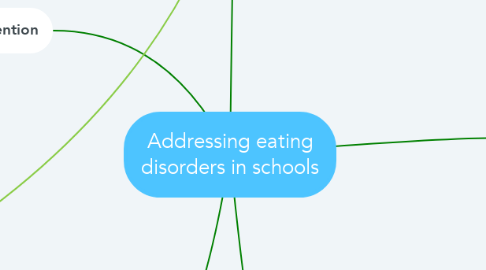
1. Prevention
1.1. Engage youth
1.1.1. Discussions about body image, body diversity, and healthy relationships with food
1.1.2. Give youth an opportunity to contribute to prevention initiatives
1.2. Engage parents
1.2.1. Provide easy-to-read handouts
1.2.2. Invite parents to talks and seminars on eating disorders
1.2.3. Provide links to information on eating disorders
1.3. Adopt "whole school approach"
1.3.1. Train teachers on eating disorders
1.3.2. Celebrate diversity at school
1.3.3. Integrate a message about positive body image into the school mission statement
1.3.4. Put posters around the school that represent many body types
1.3.5. Provide a balanced diet in school cafeteria
1.3.6. Provide opportunities for non-body image focused physical activity
1.4. Integrate eating disorder information into curriculum
1.4.1. Provide age-appropriate material for each grade level
1.4.2. Explore facts versus myths
2. Treatment
2.1. Educators should be knowledgable about basic mental health first aid
2.2. Treatment is multi-faceted
2.3. Team approach
2.4. Maintain professional boundaries
3. Early Intervention
3.1. Health-promotion approach
3.1.1. Encourage help seeking behaviours
3.1.2. Help foster resiliency
3.2. Communication with families and caregivers
3.3. Have educators be open to providing guidance and support to youth
3.4. Involve guidance teams
3.5. Address eating disorder symptoms holistically
3.5.1. Mind
3.5.2. Body
3.5.3. Spirit
3.5.4. Environment
3.6. Create support networks
4. Response
4.1. Consider risk factors
4.1.1. Psychological
4.1.1.1. Pre-existing depression or anxiety
4.1.1.2. Obsessive or compulsive personality
4.1.1.3. Low self-esteem
4.1.1.4. Trauma
4.1.1.5. Stress
4.1.2. Social/Environmental
4.1.2.1. Influence of Western beauty standards
4.1.2.2. Difficult home life
4.1.2.3. Societal pressures
4.1.2.4. Bullying
4.1.3. Physical
4.1.3.1. Genetic influences/pre-disposition to eating disorders
4.1.3.2. Puberty
4.1.3.3. Gender
4.2. Consider protective factors
4.2.1. Psychological
4.2.1.1. Positive coping skills
4.2.1.2. High self-esteem
4.2.1.3. No pre-existing mental health issues
4.2.1.4. Positive body image
4.2.2. Social/Environmental
4.2.2.1. Supportive community
4.2.2.2. Supportive family unit
4.2.2.3. Routine
4.2.2.4. Strong positive influences
4.2.3. Physical
4.2.3.1. Regulated hunger cues

